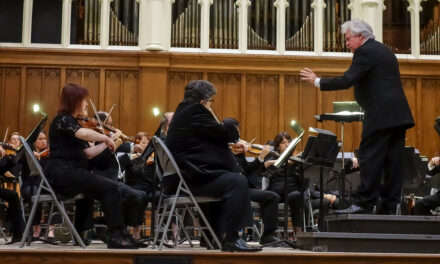Not such a long time ago in a concert hall not so very far away, the Western Piedmont Symphony took an eager audience on a tour of the galaxies through the iconic works of two composers, John Williams and Gustav Holst. Audience members were invited to attend the last concert of the Masterworks series as their favorite Star Wars character, and many of the younger people sported light sabers and capes and other fun costumes.
The WPS was joined by the Lenoir-Rhyne Youth Chorus, directed by Florence Jowers, for this concert. After a rousing rendition of the national anthem, these young students opened the concert with Z. Randall Stroope’s lovely “Homeland.” The melody is that of Holst’s “Thaxted” hymn tune, which was created from the theme of the fourth movement of The Planets. The chorus featured strong diction and clean vowels and handled the sudden unisons in this piece with sensitivity. This listener would love to hear the ensemble in mixed formation, simply from a standpoint of personal preference, but thoroughly enjoyed the performance as it was.
Stravinsky is frequently credited with the remark: “Good composers don’t borrow, they steal.” The concert highlighted the already accepted fact that John Williams is by all accounts, a “good composer.” This observation highlights the success behind the sort of cheeky programming that pairs modern cinematic soundtracks with their classical inspirations. It pleases both the pops crowd and the classical aficionados and makes anybody with an ear for imitation giggle. If you have not been so lucky as to hear this live and would like an approximation of the effect, listen to the beginning of the fourth movement of the “New World” Symphony and see if you can avoid thinking of a large and scary shark. Hopefully this experience will not ruin Dvořák for you!
John Williams received the privilege of coming first on the program, if not in history. The new edition of the score to the suite that Williams created from the Star Wars soundtrack includes the “Imperial March” and “Yoda’s Theme,” both of which were previously unavailable to the public. A few amusing connections between the composer’s pieces are worth noting. Williams’ technique of using quiet, repeated string arpeggios under a sustained note, usually in the brass section, was strikingly similar to a passage in Holst’s “Neptune.” Also pointed out in the excellent program notes was a connection between “Yoda’s Theme” and “Saturn.” Altogether, the context of both suites (Williams’ and Holst’s) back to back provided a playful puzzle for the audience without disparaging Williams’ successful habit of drawing inspiration from historic masters.
The WPS’ rendition of this collection of favorite themes had just enough of a personal stamp to keep the music fresh. The transparent sections uncovered a problem that is by no means unique to this ensemble: when there is no longer safety in numbers, the level of confidence drops and the sound becomes tentative. Their playing on the high-energy movements, however, was full of gusto and gumption and carried the enthusiastic members of the audience to their feet.
Who can resist breaking into a grin when hearing the iconic col legno opening figure of “Mars”? Unfortunately, the first four movements of The Planets were hampered by balance problems, particularly the dynamic difference between the percussion and strings. Everything on this program is also unforgiving and will always highlight every weakness of every brass section. The centerpiece fourth movement, however, played very much to Maestro John Gordon Ross’ strengths. He handled the energetic, the dramatic, the overpowering with an easy confidence and did not seem hampered by the metric creativity that characterizes this suite. While the moments of lovely introspection and intimate musicality of “Venus” were not realized to their full potential, the more boisterous movements were impressive in their energy, vitality, and dramatic expression.
The programmatic choice to end with Holst’s “Neptune,” which is anticlimactic in the best of performances, rather than with the end credits of Star Wars, seemed counter-intuitive. This orchestra, however, improved in terms of technique, ensemble, and musicality throughout the suite. The rarely played sixth and seventh movements, “Uranus” and “Neptune,” were the strongest and most effective of the night. A memorable subito transition in “Uranus” stands out clearly. The simulations interplay of challenging rhythmic figures, a dramatic ritard, and an enormous drop in dynamic level was realized to breathtaking effect.
The Lenoir-Rhyne Youth Chorus returned, albeit offstage, and contributed an absolutely indispensable element of strange beauty to the last movement. The young singers managed the counterintuitive shape and chromaticism of the melodic lines and negotiated the frequent moments of dissonance with a musical maturity beyond their years. Far from being a letdown, the eerie, otherworldly ending of “Neptune” proved the most complex and musically satisfying moment of the concert.











